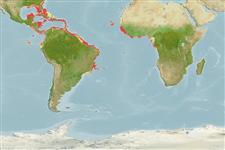Anthozoa |
Scleractinia |
Pocilloporidae
Environment: milieu / climate zone / depth range / distribution range
Ecology
Reef-associated; depth range 0 - 98 m (Ref. 83917). Tropical; 33°N - 25°S, 92°W - 12°E (Ref. 847)
Central and Southern Atlantic Ocean.
Length at first maturity / Size / Weight / Age
Maturity: Lm ? range ? - ? cm
Colonies are nodular laminar or encrusting with nodules usually flattened in section and club-shaped. Corallites are widely separated and circular to angular in outline.
Zooxanthellate (Refs. 116012, 121684). Found in low light conditions (Ref. 1663). On rocky reef , shallow to mesophotic waters (Ref. 121684).
Life cycle and mating behavior
Maturity | Reproduction | Spawning | Eggs | Fecundity | Larvae
Members of the class Anthozoa are either gonochoric or hermaphroditic. Mature gametes are shed into the coelenteron and spawned through the mouth. Life cycle: The zygote develops into a planktonic planula larva. Metamorphosis begins with early morphogenesis of tentacles, septa and pharynx before larval settlement on the aboral end.
Collin, R., M.C. Díaz, J. Norenburg, R.M. Rocha, J.A. Sánchez, M. Schulze, A. Schwartz and A. Valdés. 2005. (Ref. 415)
IUCN Red List Status (Ref. 130435)
CITES status (Ref. 108899)
Not Evaluated
Threat to humans
Human uses
| FishSource |
Tools
Internet sources
Estimates based on models
Preferred temperature
(Ref.
115969): 22.8 - 28, mean 26.8 (based on 452 cells).
Price category
Unknown.
